Common Procedures
Topics on this page

6 month regular check-up with X-Ray.
Peyton Dental Dentist Chino Hills provides the comfortable Dental X-Ray Radiograph experiences to the patients.
Regular exams are an important part of maintaining your oral health. During your regular exam, we will:
- Check for any problems that you may not see or feel
- Look for cavities or any damage to the tooth
- Inspect your teeth and gums for gingivitis and signs of periodontal disease
- Perform a thorough teeth cleaning
Your regular exam will take about 45 minutes. Each regular exam includes a detailed teeth cleaning, in which we will clean, polish, and rinse your teeth to remove any tartar and plaque that have built up on the tooth's surface.
Visiting our office every six months gives you the chance to talk to the doctor about any questions you may have about your oral health. Regular exams are offered by appointment only, so please contact our practice today to schedule your next dental exam and teeth cleaning.
Composite White Fillings
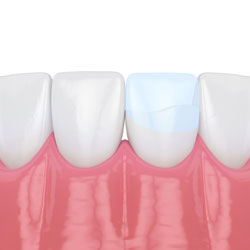
Tooth decay is the primary reason why patients experience toothaches and sensitivity. The dentist needs to remove all the decay and make the patient feel confident in their smile. For a patient to feel comfortable and smile brighter, a dentist will restore a patient's tooth with naturally aesthetic filling materials, also known as composite. Composite bonding is the most popular dental treatment to repair slightly chipped, discolored, or crooked teeth. During this treatment, a natural, tooth-colored filling is used to restore cavities or improve their appearance. Dr. Park's specialty is practicing conservative dentistry where he tries to keep more healthy tooth structure as possible. He prioritises patients' needs by saving their teeth from needing a crown. Conserving tooth structure can help teeth maintain strength and longevity.
Explicacion en espanol:
"La union" is una manera conservativa de reparar los lijeramente degastados, descoloridos y dientes torcidos. La union dental, un relleno blanco que es puesto encima de tu diente para mejorar su apariencia. El relleno se "une" con tu diente, y ya que viene en varios tonos de color de diente, se combina mucho con la apariencia de tus dientes naturales.
Bonding is less expensive than other cosmetic treatments and usually can be completed in one visit to our office. However, bonding can stain and is more fragile than other cosmetic treatments, such as porcelain veneers. If it does break or chip, tell your doctor. The bonding generally can be easily patched or repaired in one visit.
Explicacion en espanol:
Los rellenos son menos costosos que otros tratamientos cosmeticos y usualmente pueden ser completados en una visita al consultorio, Sin embargo, los rellenos pueden manchar y es mas facil que se rompan comparado con otros tratamientos cosmeticos, asi como las carillas de porcelana. Si se rompe o astilla, dile a tu doctor. Los rellenos generalmente pueden ser parchados o reparados en una visita.
Bridge
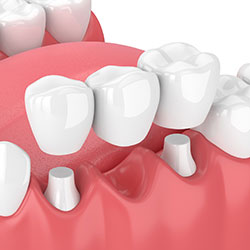
A bridge may be used to replace missing teeth, help maintain the shape of your face, and alleviate stress on your bite.
A bridge replaces missing teeth with artificial teeth, looks great, and bridges the gap where one or more teeth may have been. Your bridge can be made from gold, alloys, porcelain, or a combination of these materials and is bonded onto surrounding teeth for support.
The success of any bridge depends on its foundation: the other teeth, gums, or bone to which it is attached. Therefore, it’s very important to keep your existing teeth, gums, and jaw healthy and strong.
Explicacion en espanol:
Un puente puede ser usado para reemplazar dientes faltantes, ayuda a mantener la forma de tu cara, y aliviar el estres en tu mordida.
Un puente reemplaza dientes faltantes con dientes artificiales, se ve muy bien, y literalmente puentea el espacio donde uno o mas dientes hayan estado. Tu puente puede ser hecho de oro, aleaciones, porcelana or una combiancion de estos materiales y es unido a los dientes de alrededor para punto de apoyo.
El exito de cada puente depende en su base: los otros dientes, encias o huesos a los que esta junto. Y asi, es muy importante mantener tus dientes, encias y mandibula existente saludables y fuertes.
Crown
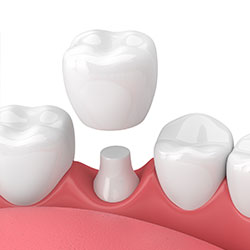
Crowns are a fixed restoration used to improve your tooth’s shape or to strengthen a tooth. Crowns are most often used for teeth that are broken, worn, or have portions destroyed by tooth decay.
Explicacion en espanol:
Las coronas son restauraciones fijas que se usan para mejorar la forma de tu diente o para reforzar el diente. Las coronas son frecuentemente usadas para los dientes que estan rotos, desgastados, o porciones que hayan sido destruidas por caries dentales.
A crown is a “cap” cemented onto an existing tooth that usually covers the portion of your tooth above the gum line. In effect, the crown becomes your tooth’s new outer surface. Crowns can be made of porcelain, metal, or both. Porcelain crowns are most often preferred because they mimic the translucency of natural teeth and are very strong.
Explicacion en espanol:
Una corona es una "tapa" cementada sobre el diente existente que usualmente cubre una porcion de tu diente arriba de la linea de la encia. En efecto, la corona se convierte la nueva superficie exterior de tu diente. Las coronas pueden ser hechas de porcelana, metal, o las dos. Las coronas de porcelana son mas frecuentemente preferidas porque hacen alucion de tu diente natural y son muy fuertes.
Crowns or onlays (partial crowns) are needed when there is insufficient tooth strength remaining to hold a filling. Unlike fillings, which apply the restorative material directly into your mouth, a crown is fabricated away from your mouth. Your crown is created in a lab from your unique tooth impression, which allows a dental laboratory technician to examine all aspects of your bite and jaw movements. Your crown is then sculpted just for you so that your bite and jaw movements function normally once the crown is placed.
Explicacion en espanol:
Las coronas o las incrustaciones (coronas parciales) son necesitadas cuando queda insificiente fuerza en el diente para sostener el relleno. A diferencia de los rellenos, que se aplica el material restaurativo directamente en tu boca, una corona es fabricada afuera de tu boca. Tu corona es hecha en un laboratorio en base a tu impresion dental, que permite al tecnico dental laboratorista a examinar todos los aspectos de tu mordida y movientos de mandibula. Tu corona despues es esculpida solo para ti, para que entonces los movimientos de tu mordida y mandibula funcionen a la normalidad una vez aque tu corona sea colocada.
Denture
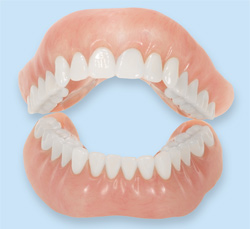
Dentures are natural-looking teeth replacements that are removable. There are two types of dentures: full and partial. Full dentures are given to patients when all of the natural teeth have been removed. Partial dentures are attached to a metal frame that is connected to your natural teeth and are used to fill in where permanent teeth have been removed. Just like natural teeth, dentures need to be properly cared for. Use a gentle cleanser to brush your dentures, always keep them moist when they’re not in use, and be sure to keep your tongue and gums clean as well.
Explicacion en espanol:
Las dentaduras son reemplazos de dientes que se ven naturales y son removibles. Hay dos tipos de dentaduras: completas y parciales. Las dentaduras completas son dadas a los pacientes cuando todos los dientes naturales han sido removidos. Las dentaduras parciales son sujetadas a un marco de metal que esta conectado va tus dientes naturales y son usados para rellenar donde los dientes permanentes fueron removidos. Asi como los dientes naturales, las dentaduras necesitan ser cuidadas apropiadamente. Usa un limpiador gentil para cepillar tus dentaduras, siempre manten tus dentaduras hidratadas cuando no estan en uso, y asegurate de mantener tu lengua y encias limpias tambien.
Extraction
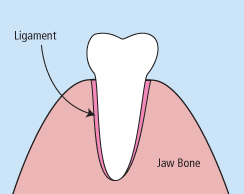
There are times when it is necessary to remove a tooth. Sometimes a baby tooth has misshapen or long roots that prevent it from falling out as it should, and the tooth must be removed to make way for the permanent tooth to erupt. At other times, a tooth may have so much decay that it puts the surrounding teeth at risk of decay, so your doctor may recommend removal and replacement with a bridge or implant. Infection, orthodontic correction, or problems with a wisdom tooth can also require the removal of a tooth.
Explicacion en espanol:
Hay veces en las que es necesario remover un diente. A veces un diente de leche no ha salido o las raices estan muy largas que hace que no se caigan como deberian, y el diente debe ser removido para abrir paso para que el diente permanente erupcione. Otras veces, un diente puede tener demasiadas caries que pone en riesgo caries a los otros dientes de alrededor, entonces tu doctor podria recomendar la remocion y reemplazo con un puente o implante. Infeccion, correccion con ortodoncia o problemas de las muelas del juicio tambien pueden requerir extraccion dental.
When it is determined that a tooth needs to be removed, your dentist may extract the tooth during a regular checkup or may request another visit for this procedure. The root of each tooth is encased within your jawbone in a “tooth socket,” and your tooth is held in that socket by a ligament. To extract a tooth, your dentist must expand the socket and separate the tooth from the ligament holding it in place. While this procedure is typically very quick, it is important to share with your doctor any concerns or preferences for sedation.
Explicacion en espanol:
Cuando es determinado que un diente debe de ser removido, tu dentista puede extraelo durante una visita regular de chequeo o puede solicitar otra visita para este procedimiento. La raiz de cada diente esta dentro de la mandibula en un "saco dental", y tu diente es sujetado a ese saco por un lugamentos. Para poder extraer un diente, tu dentista debe de expandir el saco y separar el diente del ligamento y sujetarlo en su lugar. Durante este procedimiento, es comunmente rapido, es importante compartir con tu doctor cualwuier preocupacion o preferencia de sedacion.
Once a tooth has been removed, neighboring teeth may shift, causing problems with chewing or with your jaw joint function. To avoid these complications, your dentist may recommend that you replace the extracted tooth.
Explicacion en espanol:
Una vez que el diente haya sido removido, los dientes vecinos pueden moverse, causando problemas con masticar o con la funcion del tendon de tu mandubula. Para evitar estas complicaciones, tu dentista puede recomendar que reemplazes tu diente extraido.
Filling
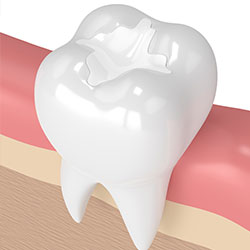
Traditional dental restoratives, or fillings, are most often made of silver amalgam. The strength and durability of this traditional dental material make it useful for situations where restored teeth must withstand extreme forces that result from chewing, often in the back of the mouth.
Explicacion en espanol:
Restauracion dental tradicional, o rellenos, son frecuentemente hechos de amalgamas de plata. La fuerza y durabilidad de este material dental tradicional lo hace util para situaciones donde los dientes restaurados deben soportar fuerzas extremas en resultado de masticar, usualmente en la parte trasera de la boca.
Newer dental fillings include ceramic and plastic compounds that mimic the appearance of natural teeth. These compounds, often called composite resins, are usually used on the front teeth where a natural appearance is important, but they can also be used on the back teeth depending on the location and extent of the tooth decay.
Explicacion en espanol:
Los rellenos dentales mas nuevos incluyen componentes de ceramica y plastico que hacen alusion de dientes naturales. Estos componentes, usualmente llamados resinas compuestas, son generalmente usadas en los dientes frontalesdonde la apariencia es importante, pero tambien pueden ser usadas en la parte trasera de los dientes dependiendo de la ubicacion de la caries dental.
There are two different kinds of fillings: direct and indirect. Direct fillings are fillings placed into a prepared cavity in a single visit. They include silver amalgam, glass ionomers, resin ionomers, and composite (resin) fillings. Indirect fillings generally require two or more visits. They include inlays, onlays, and veneers. They are used when a tooth has too much damage to support a filling but not enough to necessitate a crown.
Explicacion en espanol:
Hay dos tipos diferentes de rellenos: directos e indirectos. Los rellenos directos son rellenos que son puestos sobre la caries preparadas en una unica visita. Ellos incluye amalgamas de plata, ionomeros de vidrio, ionomeros de resina, y rellenos compuestos (resina). Los rellenos indirectos generalmente requieren una o mas visitas. Ellos incluyen incrustaciones y carillas. Ellos son usados cuando el diente tiene mucho dano como para aguantar al relleno pero no lo suficiente como para necesitar una corona.
Fluoride
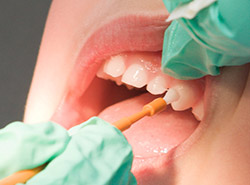
Fluoride is effective in preventing cavities and tooth decay and in preventing plaque from building up and hardening on the tooth’s surface. A fluoride treatment in your dentist’s office takes just a few minutes. After the treatment, patients may be asked not to rinse, eat, or drink for at least 30 minutes to allow the teeth to absorb the fluoride. Depending on your oral health or your doctor’s recommendation, you may be required to have a fluoride treatment every three, six, or 12 months.
Explicacion en espanol:
El fluor es efectivo para prevenir caries y prevenir la formacion de placa y endurecer la superficie dental. El tratamiento de fluor en el consultorio dental toma solo algunos minutos. Despues del tratamiento, los pacientes seran indicados a no enjuagar, comer o tomar por al menos 30 minutos para asi permitir a los dientes en absorbar el fluor. Dependiendo de tu salud oral o la recomendacion oral, a lo mejor y requieras a realizarte un tratamiento de fluor cada tres, seis o doce meses.
Implant Restoration
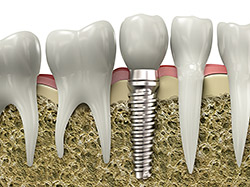
If you are missing teeth, it is crucial to replace them. Without all your teeth, chewing and eating can destabilize your bite and cause you discomfort. When teeth are missing, your mouth can shift and even cause your face to look older. Implants are a great way to replace your missing teeth, and if properly maintained, can last a lifetime!
Explicacion en espanol:
Si tienes dientes faltantes, es crucial reemplazarlos. Sin todos tus dientes, morder y comer puede destabilizar tu mordida y causar incomodidad. Cuando hay dientes faltantes, tu boca se puede mover e incluso causar que tu boca se vea mas vieja. Los implantes son una buena manera de reemplazar tus dientes faltantes, y si son propiamente tratados, pueden durar toda una vida!
An implant is a new tooth made of metal and porcelain that looks just like your natural tooth. It’s composed of two main parts: one part is the titanium implant body that takes the place of the missing root, and the second part is the tooth-colored crown that is cemented on top of the implant. With implant treatment, you can smile confidently knowing no one will ever suspect you have a replacement tooth.
Explicacion en espanol:
Un implante es una diente nuevo hecho de metal y porcelana que se ve como tu diente natural. Esta compuesto de dos partes principales: Una parte es un implante de titatio que toma el lugar de la raiz faltante, la segunda parte es la corona de diente de color que es cementada por encima del implante. Con el tratamiento de implante, puedes sonreir con seguridad sabiendo que nadie va a sospechar que tienes un reemplazo de dientes.
In addition to tooth replacement, implants may be used to anchor dentures, especially lower dentures that tend to shift when you talk or chew. For patients with removable partial dentures, implants can replace missing teeth, so you have a more natural-looking smile.
Explicacion en espanol:
En adicion al reemplazo de deinte, los implantes deber ser usados para enanchar la dentadura, especialmente las dentaduras inferiores que tienden a moverse cuando hablas o muerdes. Para los pacientes con dentaduras parcialmente removibles, los implantes pueden reemplazar los dientes faltantes asi que tu puedes tener dientes con aspecto mas natural.
Mouthguard
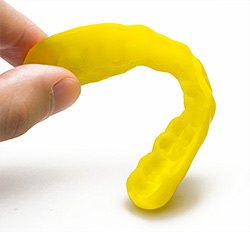
Whether you wear braces or not, protecting your smile while playing sports is essential. Mouthguards help protect your teeth and gums from injury. If you participate in any kind of full-contact sport, the American Dental Association recommends that you wear a mouthguard. Choosing the right mouthguard is essential. There are three basic types of mouthguards: the pre-made mouthguard, the “boil-and-bite” fitted mouthguard, and a custom-made mouthguard from your dentist. When you choose a mouthguard, be sure to pick one that is tear-resistant, comfortable, and well-fitted for your mouth, easy to keep clean, and does not prevent you from breathing properly. Your dentist can show you how to wear a mouthguard properly and how to choose the right mouthguard to protect your smile.
Explicacion en espanol:
Aunque uses brackets o no, proteger tu sonrisa mientras practicas deportes es escencial. Las guardas bucales ayudan a proteger tus dientes de lesiones. Si tu participas en cualquier tipo de deporte de contacto directo, la Asociacion Americana Dental recomienda que uses un guarda bucal. Elegir el guarda correcto es escencial. Hay tres tipos de guardas basicos: El guarda prehecho, el guarda "hierve y muerde" y el guarda personalizado por tu dentista. Cuando eliges un guarda bucal, asegurate de elegir uno de sea resistente a estiramientos, comodo y que se ajuste bien a tu boca, facil de mantener limpio9, y que no te impida respirar bien. Tu dentusta puede ensenarte como usar tu guarda bucal apropiadamente y como elegir la guarda correcta para proteger tu sonrisa.
Nightguard
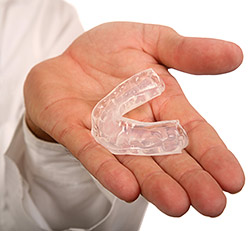
If you often wake up with jaw pain, earaches, or headaches, or if you find yourself clenching or grinding your teeth, you may have a common condition called “bruxism.” Many people do not even know that they grind their teeth, as it often occurs when one is sleeping. If not corrected, bruxism can lead to broken teeth, cracked teeth, or even tooth loss.
Explicacion en espanol:
Si frecuentemente despiertas con dolor de mandibula, dolor de oido o dolores de cabeza, o te das cuenta que estas apretando o rechinando tus dientes, tal vez tengas una condicion comun llamada "bruxismo". Muchas personas ni siquiera saben que rechinan sus dientes, asi como sucede frecuentemente cuando uno esta durmiendo. Si no es corregido, el bruxismo puede causar dientes rotos, o astillados o incluso perdida dental.
There is an easy, non-invasive treatment for bruxism: nightguards. Nightguards are an easy way to prevent the wear and damage that teeth-grinding causes over time. Custom-made by your dentist from soft material to fit your teeth, a nightguard is inserted over your top or bottom arch and prevents contact with the opposing teeth.
Explicacion en espanol:
Hay un tratameinto facil, no invasiv para el bruxismo: guardas bucales nocturnas. Las guardas nocturnas son una manera facil de prevenir el desgaste y dano de rechinar los dientes con el tiempo. Perzonalizados por tu dentista de un material suave para ajustarse a tus deintes, una guarda nocturna es puesta sobre tu paladar superior y posterior y prevenir contacto con los dientes opuestos.
Root Canal Treatment(RCT)
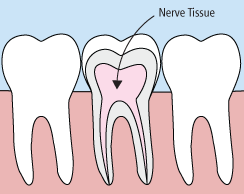
In the past, if you had a tooth with a diseased nerve, you'd probably lose that tooth. Today, with a special dental procedure called “root canal treatment,” your tooth can be saved. When a tooth is cracked or has a deep cavity, bacteria can enter the pulp tissue, and germs can cause an infection inside the tooth. If left untreated, an abscess may form. If the infected tissue is not removed, pain and swelling can result. This can not only injure your jawbones, but it is also detrimental to your overall health.
Explicacion en espanol:
En el pasado, si tu tenias un diente con el nervio infectado, podrias perder ese diente. Hoy con un procedimiento dental especial llamado "tratamiento de canal de raices", pueden salvar tu diente. Cuando el diente esta astillado o tiene una caries muy produnfa, la bacteria puede entrar en el tejido y los germenes pueden causar una infeccion adentro del diente. Si lo dejas sin tratar, se puede formar un abceso. Si el tejido infectado no es removido, puede resultar en dolor e hinchazon. Esto no solo puede lesionar los huesos de tu mandibula, si no que tambien puede afectar tu salud general.
Root canal treatment involves one to three visits. During treatment, your general dentist or endodontist (a dentist who specializes in problems with the nerves of the teeth) removes the affected tissue. Next, the interior of the tooth will be cleaned and sealed. Finally, the tooth is filled with a dental composite. If your tooth has extensive decay, your doctor may suggest placing a crown to strengthen and protect the tooth from breaking. As long as you continue to care for your teeth and gums with regular brushing, flossing, and checkups, your restored tooth can last a lifetime.
Explicacion en espanol:
El tratamiento del canal de las raices implica de una a tres visitas. Durante el tratamiento, tu dentista general o endodoncista (un dentista que se especializa en problemas con los nervios de los dientes) remueve el tejido infectado. Siguiente, el interior del diente sera limpiado y sellado. Finalmente, el diente es rellenado con un compuesto dental. Si tu diente tiene una caries grande, tu doctor tal vez sugiera poner una corona para reforzar y proteger el diente de romperse. Siempre y cuando tu continues cuidando tus dientes y encias con cepillados regulares, el uso de hilo dental, y chequeos regulares, tus dientes restaurados pueden durar toda una vida.
Sealant
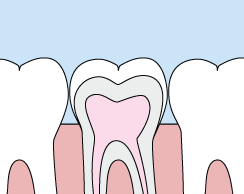
Sometimes brushing is not enough, especially when it comes to those hard-to-reach spots in your mouth. It is difficult for your toothbrush to get in between the small cracks and grooves on your teeth. If left alone, those tiny areas can develop tooth decay. Sealants give your teeth extra protection against decay and help prevent cavities.
Explicacion en espanol:
A veces el cepillado no es suficiente, especialmente cuando se trata de esos lugares dificiles de alcanzar en tu boca. Es dificil para tu cepillo alcanzar entre esas pequenas rupturas y relieves de tus dientes. Si se deja asi, esas areas pequenas pueden desarrollar caries dentales. Los selladores le dan a tus dientes una proteccion y prevencion extra contra las caries dentales.
Dental sealants are plastic resins that bond and harden in the deep grooves on your tooth’s surface. When a tooth is sealed, the tiny grooves become smooth and are less likely to harbor plaque. With sealants, brushing your teeth becomes easier and more effective against tooth decay.
Explicacion en espanol:
Los selladores dentales son resinas plasticas que juntan y endurecen los relieves profundos en la superficie de tu diente. Cuando un diente es sellado, esos relieves se convierten suaves y menos probables de poder formar placa. Con los selladores, cepillar tus dientes se convierte mas facil y mas efectivo contra caries dentales.
Sealants are typically applied to children’s teeth as a preventive measure against tooth decay after the permanent teeth have erupted. However, adults can also receive sealants on healthy teeth. It is more common to seal “permanent” teeth rather than “baby” teeth, but every patient has unique needs, and your dentist will recommend sealants on a case-by-case basis.
Explicacion en espanol:
Los selladores son tipicamente aplicados en ninos como una medida de prevencion contra las caries dental despues de que los dientes permantentes hayan erupcionado, Sin embargo, los adultos pueden recibir selladores en dientes saludables. Es mas comun sellar dientes "permanentes" que dientes de leche, pero con cada paciente que tiene nececidades unicas, y tu dentista recomienda selladores en caso por caso.
Sealants last from three to five years, but it is fairly common to see adults with sealants still intact from their childhood. A dental sealant only provides protection when it is fully intact, so if your sealants come off, let your dentist know and schedule an appointment for your teeth to be re-sealed.
Explicacion en espanol:
Los selladores duran de tres a cinco anos, pero justamente es comun ver a adultos con selladores intactos de su infancia. Un sellador dental solo provee proteccion cuando es completamente intacto, asi que si tus selladores se caen, deja saber a tu dentista, y agenda una cita para que tus dientes sean sellados nuevamente.
Veneer
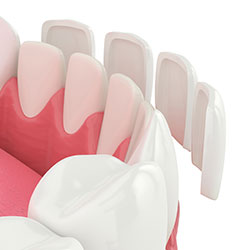
You no longer need to hide your smile because of gaps, chips, stains, or misshapen teeth. With veneers, you can easily correct your teeth’s imperfections to help you have a more confident, beautiful smile. Veneers are natural in appearance, and they are a perfect option for patients wanting to make minor adjustments to the look and feel of their smile.
Explicacion en epanol:
No necesitas esconder tu sonrisa de espacios, destastes, manchas, o dientes faltantes. Con carillas tu puedes facilmente corregir las imperfecciones para ayudar a tener seguridad y una bonita sonrisa. Las carillas son naturales en apariencia, son la perfecta opcion para los pacientes que quieren tener ajustes menores a la apariencia y sensacion de su sonrisa.
Veneers are thin, custom-made shells made from tooth-colored materials (such as porcelain), and they are designed to cover the front side of your teeth. To prepare for veneers, your doctor will create a unique model of your teeth. This model is sent to the dental technician to create your veneers. Before placing your new veneer, your doctor may need to conservatively prepare your tooth to achieve the desired aesthetic result.
Explicacion en espanol:
Las carillas son caparazones delgados y personalizados hechos de material de colores (como la porcelana), y estan disenados para cubir la parte frontera de tus dientes. Para prepararte para carillas, tu doctor creara un unico modelo de tus dientes. Este modelo sera enviando con un tecnico dental para crear tus carillas. Antes de poner tus nuevas carillas, tu doctor puede necesitar preparar conservativamente tus dientes para poder alcanzar un resultado estetico.
When your veneers are placed, you’ll be pleased to see that they look like your natural teeth. While veneers are stain-resistant, your doctor may recommend that you avoid coffee, tea, red wine, and tobacco to maintain the beauty of your new smile.
Explicacion en espanol:
Cuando tus carillas son colocadas, te pediran que veas que lucen como tus dientes naturales. Aunque tus carillas sean resistentes a manchar, tu doctor te puede recomendar el evitar cafe, te, vino tinto y tabaco para mantener lo bonito de tu nueva sonrisa.
Wisdom Teeth
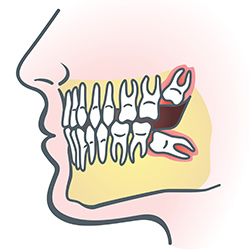
Wisdom teeth are types of molars found in the very back of your mouth. They usually appear in the late teens or early twenties, but may become impacted (fail to erupt) due to lack of room in the jaw or angle of entry. When a wisdom tooth is impacted, it may need to be removed. If it is not removed, you may develop gum tenderness, swelling, severe pain, or even an infection. Impacted wisdom teeth that are partially or fully erupted tend to be quite difficult to clean and are susceptible to tooth decay, recurring infections, and even gum disease.
Explicacion en espanol:
Las muelas del juicio son tipos de molares que se encuentran hasta atras de tu boca. Ellas usualmente aparecen en la adolescencia o entrando a tus veintes, pero pueden volverse impactadas (fallan en erupcionar) debido a la falta de espacio en la mandibula o el angulo de entrada. Cuando las muelas del juicio son impactadas, pueden necesitar ser removidas. Si no son removidas puedes desarrollar sensibilidad en las encias, inflamacion, o dolor severo. Las muelas del juicio impactadas son parcialmente completamente erupcionadas tienden a ser mas dificiles de limpiar y son mas suceptibles de caries dentazles, recurriendo a infecciones y enfermedad de encias incluso.
Wisdom teeth are typically removed in the late teens or early twenties because there is a greater chance that the teeth’s roots have not fully formed and the bone surrounding the teeth is less dense. These two factors can make extraction easier as well as shorten the recovery time.
Explicacion en espanol:
Las muelas del juicio son tipicamente removidas al final de la adolescencia o en tus veintes porque hay mejor oportunidad de que las raices dentales no hayan crecido completamente y el hueso de alrededor sea menos denso. Estos dos factores hacen la extraccion mas facil y la recuperacion mas corta.
To remove a wisdom tooth, your dentist first needs to numb the area around the tooth with a local anesthetic. Since the impacted tooth may still be under the gums and embedded in your jawbone, your dentist will need to remove a portion of the covering bone to extract the tooth. To minimize the amount of bone that is removed with the tooth, your dentist will often “section” your wisdom tooth so that each piece can be removed through a small opening in the bone. Once your wisdom teeth have been extracted, the healing process begins. Depending on the degree of difficulty related to the extraction, healing time varies. Your dentist will share with you what to expect and provide instructions for a comfortable, efficient healing process..
Explicacion en espanol:
Para poder remover tus muelas del juicio, tu dentista necesita anestesiar el area alrededor del diente con anestesia local. Ya que el deinte impactado puede estar debajo de las encias y dentro de los huesos de tu mandibula, tu dentista necesita remover una porcion del hueso que cubre para poder extraer el hueso. Para poder minimizar el hueso que es removido con el diente, tu dentista necesitara seccionar tus muelas del juicio para que cada pieza pueda ser removida en una abertura pequena en el hueso. Una vez que tus muelas del juicio hayan sido extraidas, el proceso de sanacion empieza. Dependiendo en el grado de dificultad relacionado con la extraccion, el tiempo de sanacion varia. Tu dentista te dira todo lo que debes esperar y te dara introducciones para una comoda y eficiente recuperacion.
